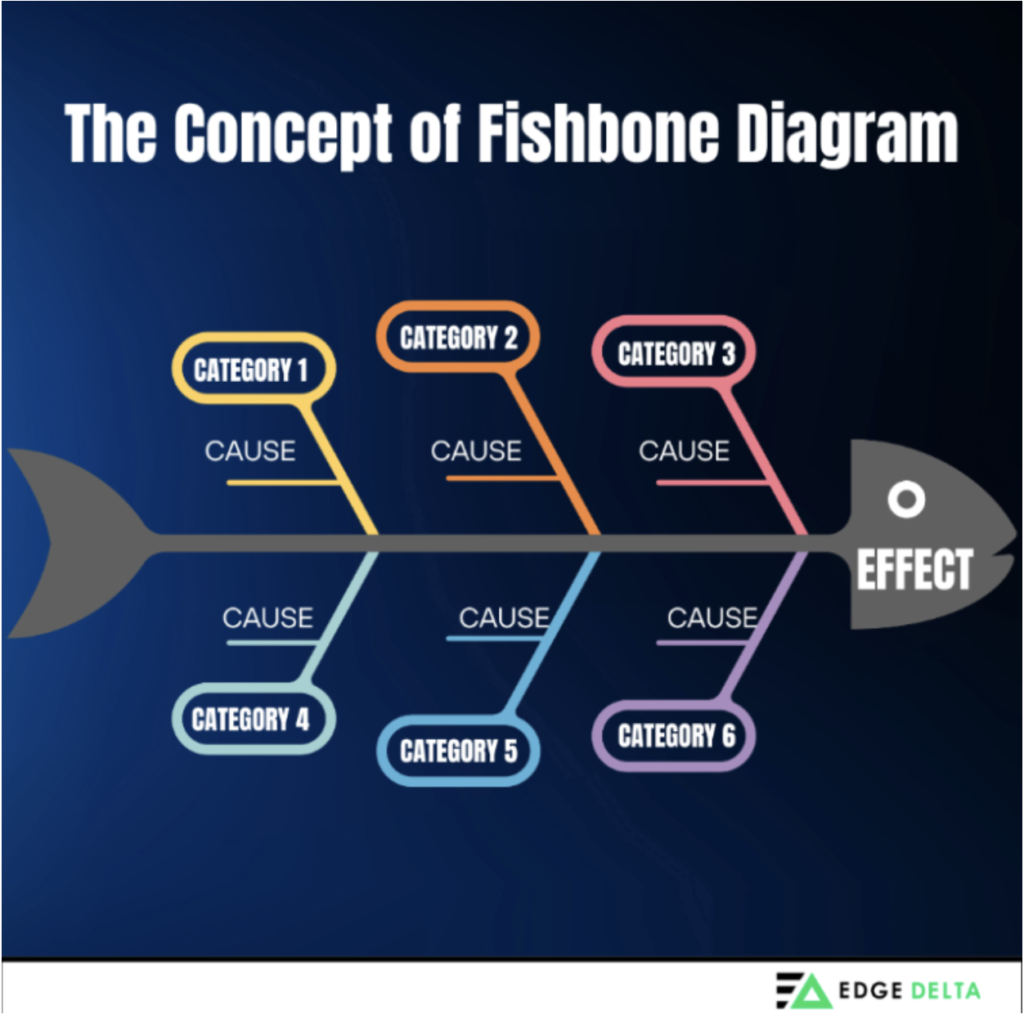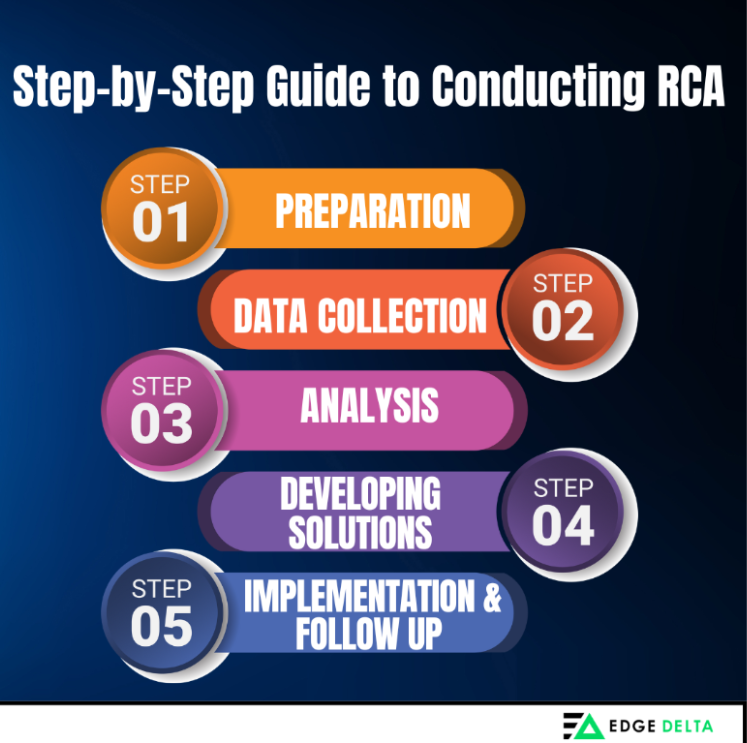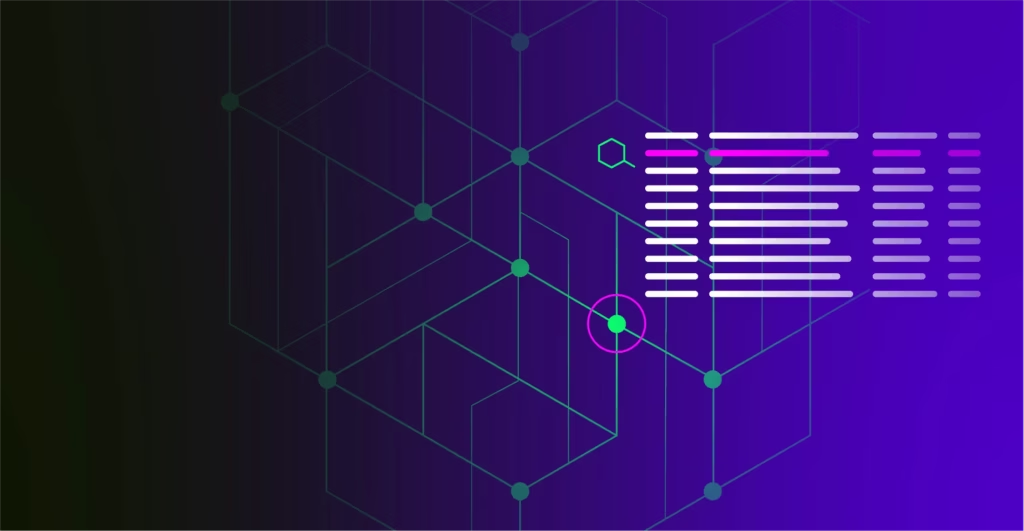Root Cause Analysis (commonly abbreviated as RCA) is a process used to identify the underlying cause of a problem, focusing on the fundamental issue(s) instead of only addressing the downstream symptoms. While potentially more difficult in the short-term, RCA produces solutions which tackle the root of the problem, saving a lot of time down the road.
In the contexts of IT infrastructures, microservices, observability, and monitoring, RCA can be applied to systematically track down the root cause of issues or failures in complex technology systems. When performance problems, errors, or outages occur, developers can leverage RCA to analyze log, metric, and trace data to help determine the exact cause.
This article will explore the principles, techniques, and real-world applications of root cause analysis in depth.
Key Takeaways
- RCA is used by organizations to uncover the root cause of their problems and identify the best solution.
- Integrating RCA is influential across industries, improving quality, efficiency, and safety. These industries include business, manufacturing, engineering, and more.
- Organizations can collect data using multiple techniques, including fishbone diagrams, failure mode, effects analysis, and change or event analysis.
Key RCA Principles
Here are five principles which are important to consider when performing RCA:
- Focus on Causes, Not Symptoms
- Explore connections between Root Causes
- Perform fact-based Analysis
- Execute a non-punitive approach
- Derive actionable solutions

Let’s break down each one:
Focus on Causes, Not Symptoms
Symptoms are the immediate issues observed by users, while root causes are the underlying factors which lead to them occurring. Addressing symptoms alone can provide temporary relief, but identifying and resolving root causes leads to lasting solutions.
By focusing on root causes, organizations can tackle problems effectively and swiftly identify improvement areas. This approach not only prevents future breakdowns but also ensures more reliable and efficient operations.
Additionally, understanding and addressing root causes can enhance system resilience, reduce downtime, and optimize resource utilization. This approach helps in building a more robust infrastructure, capable of withstanding and quickly recovering from present and future issues.
Multiple Root Causes
Organizational problems often stem from multiple interrelated root causes. A thorough root cause analysis (RCA) can not only identify and examine these individually, but also uncover how they are connected, providing a comprehensive understanding of the underlying issue. This approach also explores contributing factors, enabling more effective and holistic solutions.
Organizations often use methods like the “Five Whys” or fishbone diagrams to dissect problems into multiple root causes. This systematic approach ensures that all aspects of the issue are addressed.
Fact-based Analysis
Relying solely on assumptions or intuition can lead to successful fixes, but more often than not leads to impractical and ineffective solutions. Therefore, gathering and analyzing data through evidence-based investigations is crucial for accurately understanding organizational problems. Additionally, ensuring data reliability and accuracy is essential for both supporting any findings and ultimately making informed decisions.
Organizations can collect data through various methods such as interviews, observations, document reviews, and case studies. This fact-based approach ensures that conclusions are grounded in solid evidence, leading to more effective and credible solutions.
Non-punitive Approach
In addressing issues, it is essential to encourage openness and focus on the how/why, not the who. A blame-free environment motivate employees to communicate information freely, leading to a more accurate and comprehensive understanding of the problem. Additionally, most issues are systematic in nature, caused by improper build frameworks or testing mechanisms, meaning no one individual is entirely culpable.
It is also essential to emphasize a clear objective amongst team members and improve processes rather than just assigning blame. This system can foster cooperation and contribute to the fast discovery of issues arising within the organization.
Actionable Solutions
Ensure that the analysis leads to practical solutions to prevent the recurrence of the problems. These solutions should identify root causes effectively and be practical to implement. More concretely, they should be:
- Specific
- Achievable
- Measurable
Monitoring and follow-ups are also necessary to sustain improvements. These actionable mechanisms can ensure that the generated solutions are practical and working as intended, allowing essential adjustments.
The section below shows how organizations implement the fundamental principles of RCA in their operations.
Common Techniques and Methods in RCA
Fishbone diagram (Ishikawa)
The Fishbone Diagram, also known as Ishikawa Diagram, is a cause-and-effect style diagram that provides context around an issue’s root cause. It is particularly prominent in identifying the multiple causes that contributed to a problem.
The diagram resembles a fish structure, with the effect or problem analyzed in the fish’s head. The fish’s skeletal structure represents the combinations of causes which led to the issue, where each individual cause is represented as a specific bone in the skeleton. Some potential categories of causes are listed below:
- Workforce: Factors related to the individual people involved.
- Method: Procedures and processes followed.
- Machines: Equipment and root cause analysis tools utilized.
- Mission: The goal and objective.
- Materials: Materials and substances used in the process.
- Promotion: Marketing efforts.
- Suppliers: Product providers.
- Measurements: Measurement and data collection methods.
- Management: Approaches and organization of materials.
- Environment: The surrounding conditions and external factors.

Using the Fishbone diagram, team members first brainstorm within each present category and identify potential causes of the problem. This collaborative approach promotes in-depth understanding and ensures that all factors are overlooked.
Failure Mode and Effective Analysis
Failure Mode and Effective Analysis (FMEA) is a rigid approach to root cause analysis. Like a risk analysis, FMEA identifies every possibility for system and process failure and examines the potential impact of each hypothetical failure. The organization then addresses every root cause that is likely to fail. There are four steps in FMEA include:
- Identify potential failures and defects
- Determine the potential severity and consequences of each
- Create systems for failure detection
- Predict the likelihood of occurrence
Successful use of FMEA requires using data and insights gained from previous experiences with similar products and systems. The object is to identify failure modes and failure effects. A failure mode is a system’s potential or actual defects or errors. A failure effect describes how a failure mode will impact customers or end users.
Change/Event Analysis
Change (or Event) analysis is another method which can change systems and performance processes within the organization. When conducting this type of RCA approach, head departments examine how the circumstances relating to the issue or incident have changed, including examining changes in personal information, data, and infrastructure.
Instead of focusing on the specific day or time the problem occurred, this approach focuses on a more extended period and explores its historical context. To implement change analysis, organizations usually follow these steps:
- Listing down all possible causes of an event that causes occurrences of changes
- Categorizing each change or event according to the organization’s influence can be external or internal.
- Examining events segmenting whether it’s an unrelated factor, correlated factor, or a possible cause.
- Analyzing how to replicate or remedy the cause.
Now that you have learned the techniques used in RCA, follow along as we outline the specific steps taken to implement it into your processes.
Pro Tip
You can use distributed tracing to analyze changes or events. This process covers application requests from the front to the back end, enabling real-time visibility across an infrastructure or environment.
Step-by-step Guide to Conducting RCA – How To Do Root Cause Analysis
Conducting a thorough Root Cause Analysis (RCA) requires a systematic and structured approach. Here’s a step-by-step guide to effectively performing RCA:

Step 1: Preparation and Definition
Understanding the problem in detail is crucial as it sets the foundation for the entire analysis process. This step involves gathering initial information about the symptoms and the context in which the problem occurred. Gather a diverse team within your organization with experience in the relevant within the organization so you can clearly describe the issues and their impact.
When your department clearly understands the problem, you can begin drafting a problem statement that spells out the issue for everyone who will help with the RCA.
Step 2: Data Collection
This process includes collecting various data sources. This includes telemetry data like logs and metrics, along with testimonies like witness accounts. Methods for collecting data can include:
- Interviews: Talking to individuals involved or affected by the issue.
- Observations: Directly observing the processes and activities where the problem occurred.
- Document Reviews: Examining relevant documents, records, and reports.
- Case Studies: Reviewing similar past incidents to draw parallels and insights.
Some questions that should be considered when collecting data include the following:
- When did the problem start, and how long has it happened?
- What symptoms has the team observed?
- What documentation must the organization or department use to prove that an issue exists?
- How did the issue affect the stakeholders and other employees?
- Who was affected or harmed by the existence of this problem?
Step 3: Analysis
Use RCA techniques like the five whys or the fishbone diagram to map out the context around the issue based on the data collected, to better understand the situation.
Developing a practical root cause analysis process requires being open to all potential underlying issues and causes. Therefore, everyone on the RCA team should enter the brainstorming and analysis stage with an open mind.
Note
Searching for the root cause of issues takes time due to noise and chaotic log data. You can go around this RCA roadblock by using third-party tools. For instance, Edge Delta structures every log data into patterns, allowing teams to observe entire environments and immediately get the data needed from noisy datasets. This feature detects new behaviors and provides solutions to problems as they occur.
Step 4: Developing Solutions
Once the organization’s team members and stakeholders have determined the root causes and can fill out all the details of the issue, they can start brainstorming for solutions. They must formulate actionable solutions based on the identified root causes.
It is also crucial to consider the logistics and factors of executing the solution and any potential obstacles the team may encounter. Ensure solutions are practical, sustainable, and prevent recurrence. These elements comprise the action plan to help the team solve the current problem and prevent recurrences.
Step 5: Implementation and Follow-up
The final RCA step is to implement the solutions necessary to solve the problem within the organization. Develop a plan or a timeline for implementing the solution and inform the team involved about proactive quality management.
Once you have successfully implemented your solution, monitoring its effectiveness is necessary. Ensure that your solution solves the problem and avoids problems along the way. Monitoring feedback and new data in the long run is also helpful.
Wrap Up
Root Cause Analysis (RCA) is a powerful approach that allows organizations to identify the source of a problem. With an effective RCA process, teams can implement suitable lasting solutions to significantly improve their performance.
Organizations can harness RCA’s potential using Failure Mode, Event Analysis, and Fishbone analysis. They should also adhere to methods and best practices such as setting clear objectives, gathering diverse teams, standardizing processes, and encouraging a blame-free culture, which can help integrate RCA to avoid recurring problems.
FAQs on Root Cause Analysis
What is the meaning of root cause analysis?
Root cause analysis is a technique for discovering the root causes of problems within an industry and identifying appropriate solutions.
What are the 5 steps of root cause analysis?
The five steps of root cause analysis involve defining the problem, log collection, identifying the root causes, prioritizing the causes, and implementing solutions.
What is the meaning of root cause analysis in ITIL?
Root Cause Analysis in ITIL (Information Technology Infrastructure Library) systematically exposes the underlying issues behind IT service disruptions.
What are the 5 Whys root cause analysis?
The 5 Whys in root cause analysis are deeply rooted in the idea that asking five “Why?” questions can help organizations identify the root cause of underlying problems.






